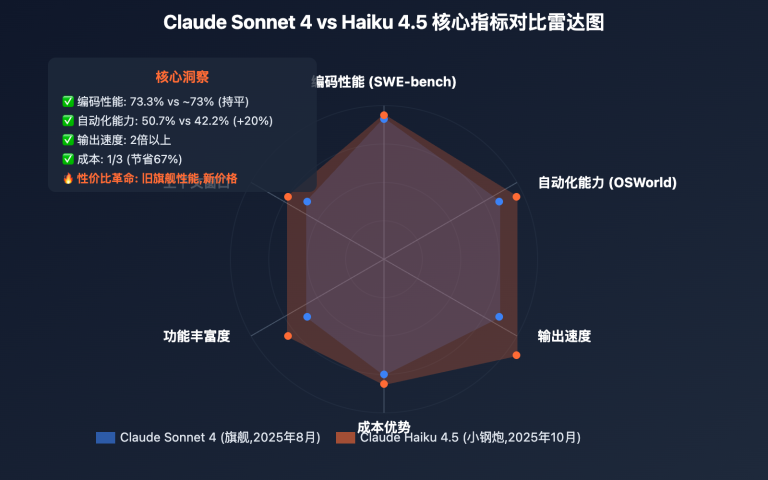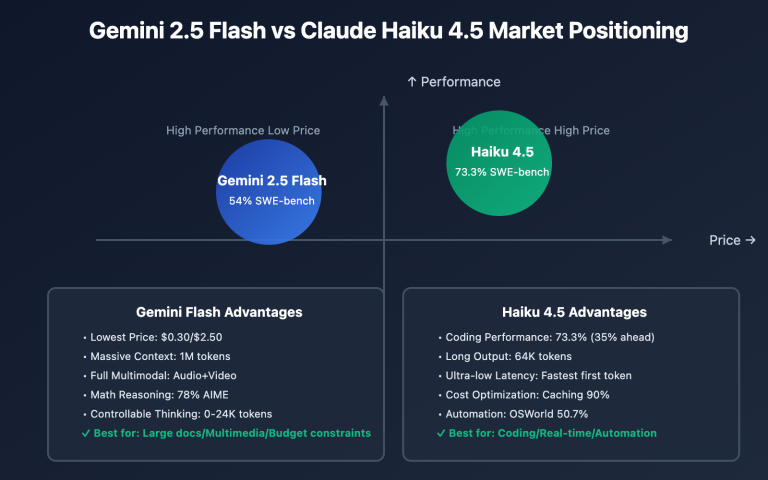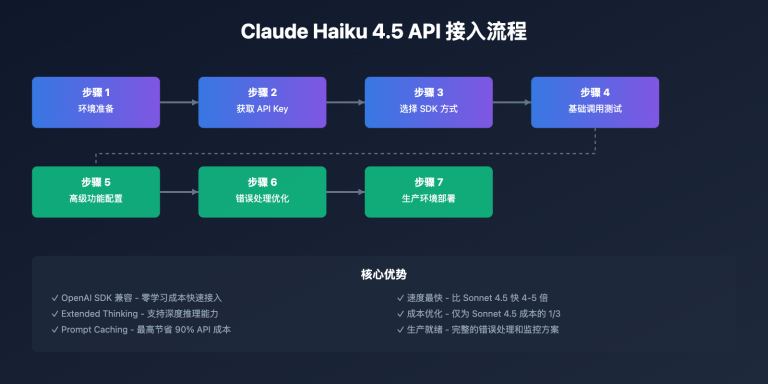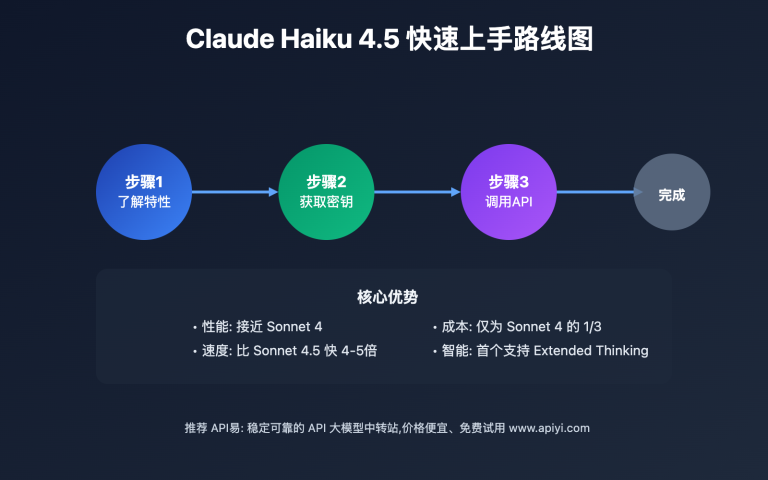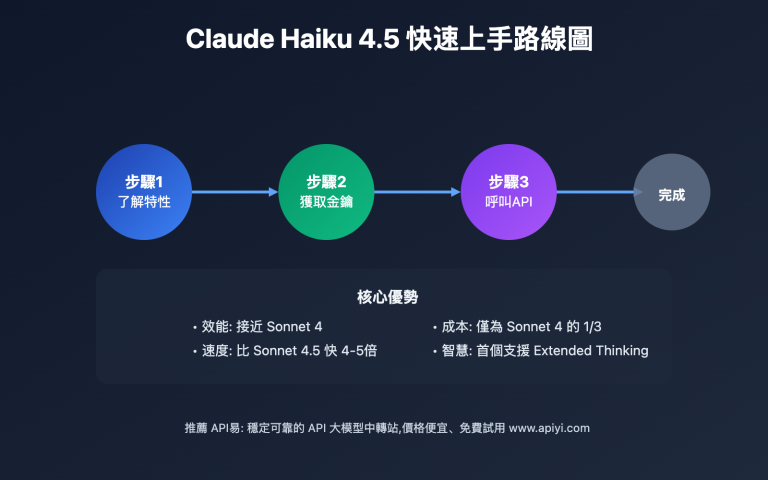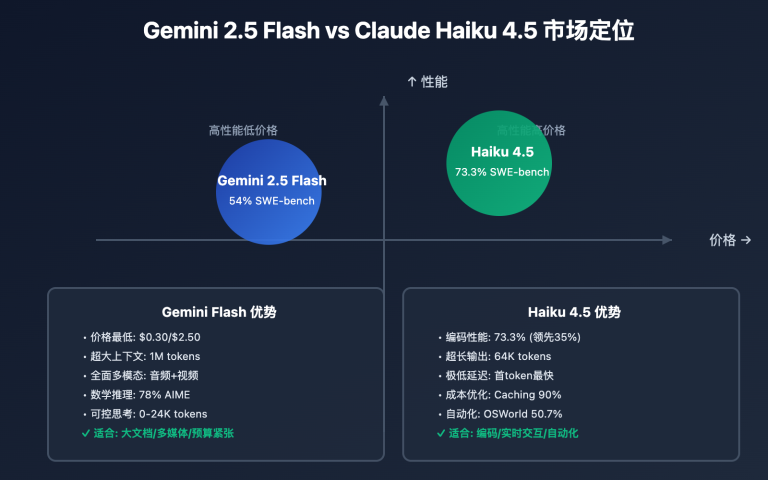Author's Note: Complete Claude Haiku 4.5 beginner's guide covering quick start, API calls, parameter configuration, Extended Thinking usage and other core content to help you get started in 5 minutes
Claude Haiku 4.5 is Anthropic's latest small high-performance model released in October 2025, officially positioned as the "fastest near-frontier intelligent model." While maintaining performance close to Sonnet 4 level, it achieves 2x+ speed improvement and only one-third the cost.
For developers who want to quickly get started with this model, this article will start from scratch and detail Claude Haiku 4.5's core features, acquisition methods, calling methods, and best practices, helping you master this powerful AI model in 5 minutes.
Core Value: Through this article, you will learn how to quickly deploy and use Claude Haiku 4.5, master advanced features like Extended Thinking, and significantly improve development efficiency.
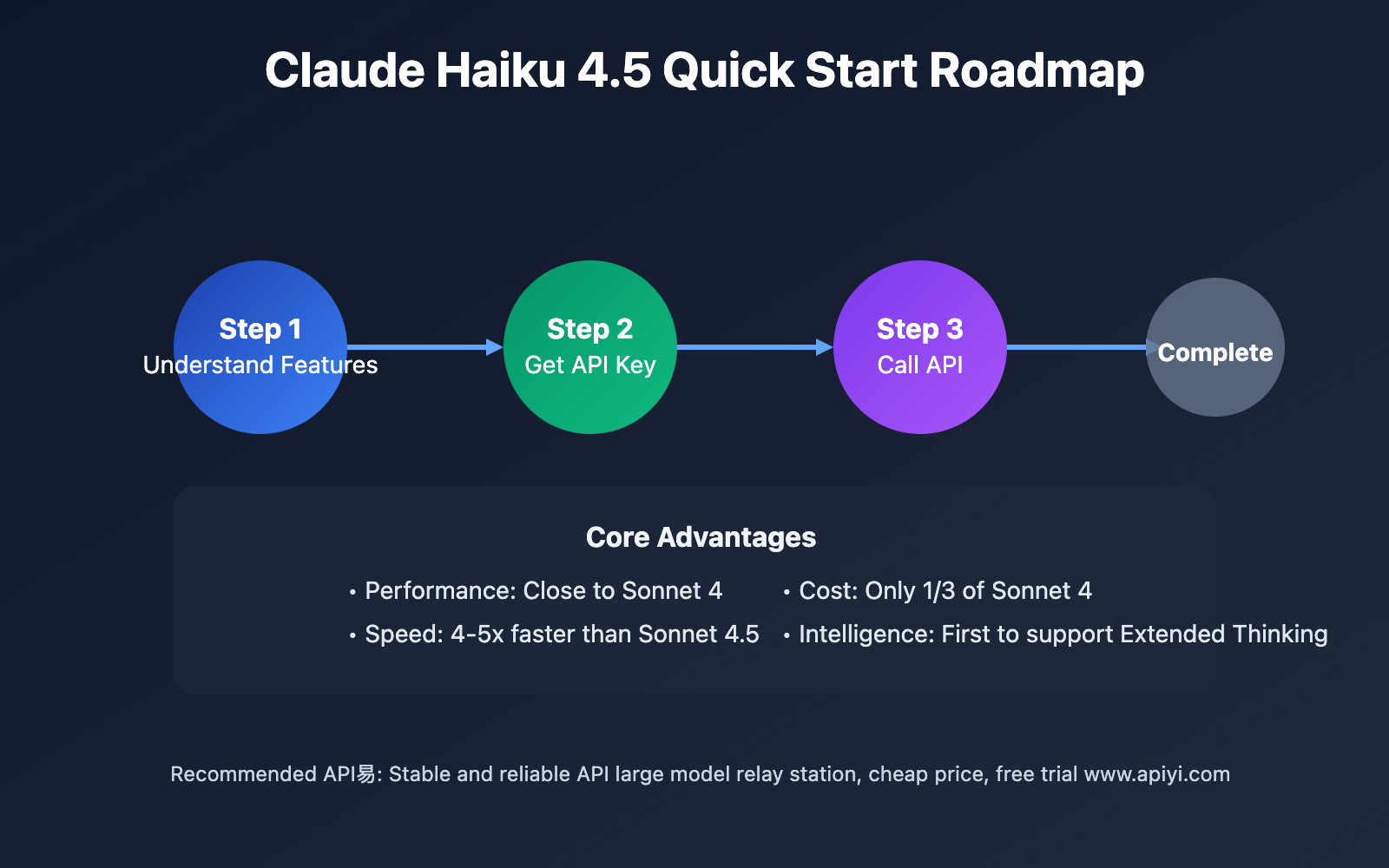
Claude Haiku 4.5 Beginner's Guide: Core Features Overview
Claude Haiku 4.5 is Anthropic's latest small high-performance model, designed for scenarios requiring fast response, high concurrency, and cost optimization.
🎯 Positioning and Core Advantages
| Core Metrics | Claude Haiku 4.5 Performance | Comparison |
|---|---|---|
| Performance Positioning | Near-frontier intelligence | Achieves Sonnet 4 level coding capability |
| Response Speed | 2x+ faster than Sonnet 4 | 4-5x faster than Sonnet 4.5 |
| Cost Advantage | $1/$5 (input/output) | Only 1/3 of Sonnet 4 cost |
| Context Window | 200K tokens | Supports ultra-long conversations |
| Maximum Output | 64K tokens | Suitable for long text generation |
🔥 Technical Highlights
Extended Thinking (Extended Reasoning)
Claude Haiku 4.5 is the first Haiku model to support Extended Thinking, a revolutionary feature:
- Deep Reasoning: The model can perform complex logical reasoning
- Thinking Summary: Automatically summarizes thinking processes
- Cross-thinking: Interweaves thinking steps during task execution
- Configurable Budget: Default 128K tokens, flexibly adjustable
Context Awareness (Context Awareness)
This is the first Haiku model to support context awareness:
- Token Tracking: Real-time tracking of token usage in conversations
- Task Persistence: Better maintenance of long conversation context
- Multi-context Workflows: Supports complex multi-turn conversation scenarios
Tool Ecosystem Compatibility
- ✅ Compatible with all Claude 4 series tools
- ✅ Supports parallel tool execution
- ✅ Optimized desktop and browser interaction
- ✅ Visual capabilities (image understanding)
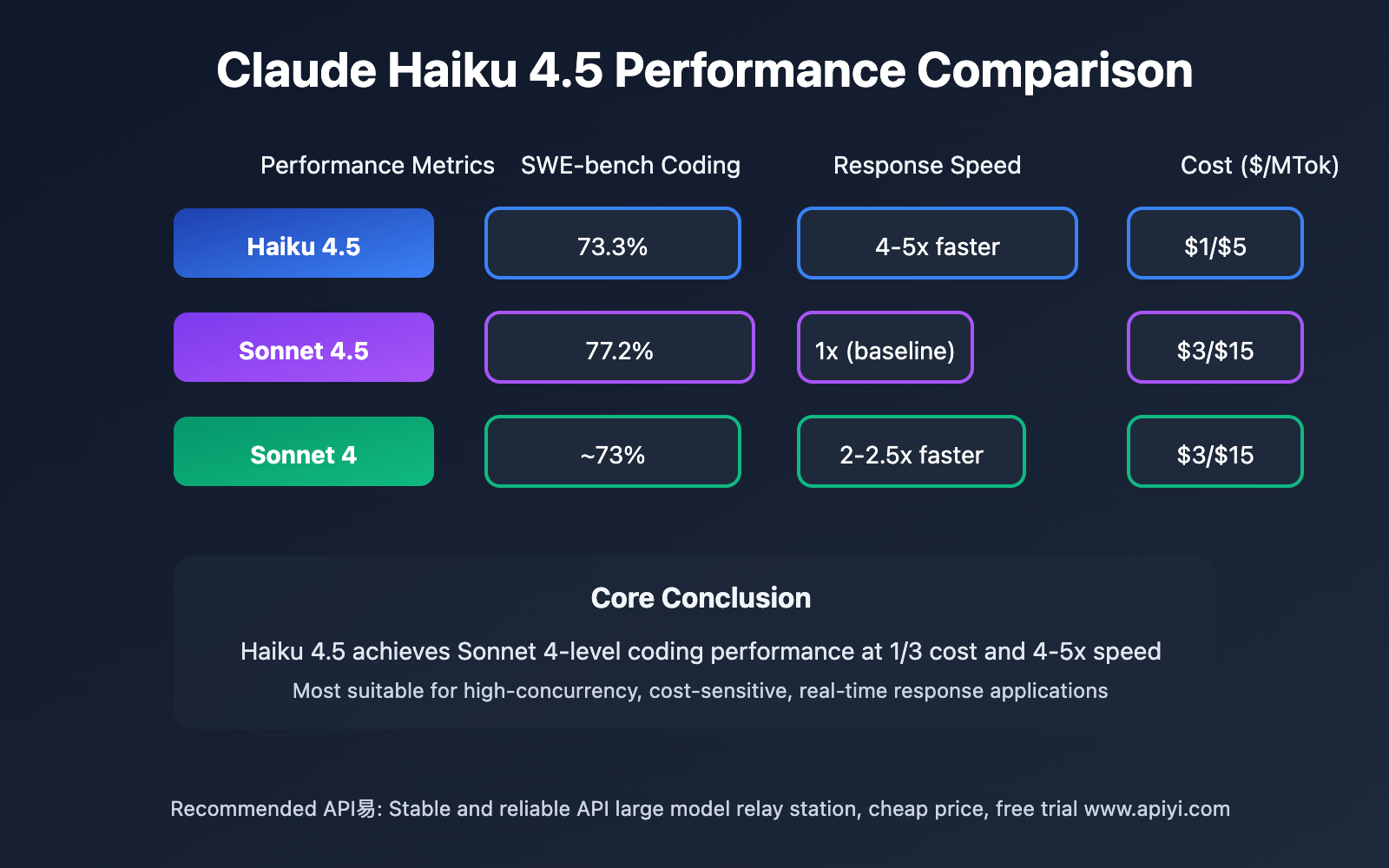
Claude Haiku 4.5 Beginner's Guide: Multiple Ways to Get API Key
To use Claude Haiku 4.5, you first need to get an API Key. Depending on different needs, there are multiple ways to obtain it.
Method 1: Anthropic Official Platform
Applicable Scenarios: Enterprise users requiring official support and high stability requirements
Steps to Obtain:
- Visit console.anthropic.com to register an account
- Complete email verification and identity authentication
- Enter API Keys page to create key
- Top up account (supports credit cards)
- Start using Claude API
Advantages:
- ✅ Official direct connection, highest stability
- ✅ Complete technical documentation and support
- ✅ New users get free credits
Disadvantages:
- ❌ Requires international credit card
- ❌ Access restricted in some regions
- ❌ Official standard pricing
Method 2: Cloud Platform Access
AWS Bedrock
Model ID: anthropic.claude-haiku-4-5-20251001-v1:0
Suitable for enterprises with existing AWS infrastructure, can be enabled directly in AWS console.
Google Vertex AI
Model ID: claude-haiku-4-5@20251001
Suitable for GCP ecosystem users, deeply integrated with Google Cloud services.
Method 3: Third-party API Relay Platform (Recommended)
Applicable Scenarios: Individual developers, small and medium enterprises, users needing quick start
Recommended Platform: API易 apiyi.com
Core Advantages:
- ✅ No international credit card needed, supports Alipay/WeChat Pay
- ✅ Better pricing, provides free trial credits
- ✅ Compatible with OpenAI interface format, no code modification needed
- ✅ Unified management of multiple models, one-click switching
- ✅ Fast domestic access speed, high stability
Steps to Obtain:
- Visit apiyi.com to register an account
- Complete email verification (no international authentication needed)
- Claim free trial credits
- Create API Key in console
- Select Claude Haiku 4.5 model to start calling
🎯 Selection Recommendation: For domestic developers and small-medium enterprises, we recommend prioritizing access through the API易 apiyi.com platform. This platform not only provides more convenient payment methods and better pricing, but also supports unified interface calls for multiple mainstream models, significantly reducing model switching costs.
Method 4: Enterprise Custom Solutions
For large-scale commercial scenarios, you can contact Anthropic or partners to get enterprise custom solutions, including:
- Dedicated API channels
- Customized SLA guarantees
- Technical support and consulting services
- Bulk discount pricing
Claude Haiku 4.5 Beginner's Guide: Basic Call Examples
After obtaining the API Key, you can start calling Claude Haiku 4.5. Here are calling examples for three mainstream languages.
Python Call Example
import anthropic
# Initialize client
client = anthropic.Anthropic(
api_key="your_api_key_here"
)
# Basic call
message = client.messages.create(
model="claude-haiku-4-5-20251001",
max_tokens=1024,
messages=[
{"role": "user", "content": "Explain what machine learning is in one sentence"}
]
)
print(message.content[0].text)
Calling through API易 Platform (OpenAI Compatible Format)
import openai
# Configure client
client = openai.OpenAI(
api_key="your_apiyi_key",
base_url="https://vip.apiyi.com/v1"
)
# Call Claude Haiku 4.5
response = client.chat.completions.create(
model="claude-haiku-4-5",
messages=[
{"role": "system", "content": "You are a professional technical consultant"},
{"role": "user", "content": "Recommend a cost-effective AI model"}
]
)
print(response.choices[0].message.content)
🔍 Platform Selection Recommendation: If your project already uses OpenAI interface format, you can seamlessly switch to Claude Haiku 4.5 through API易 apiyi.com without modifying existing code architecture. The platform provides fully compatible interfaces while supporting unified calls for multiple models.
JavaScript/Node.js Call Example
import Anthropic from "@anthropic-ai/sdk";
const anthropic = new Anthropic({
apiKey: "your_api_key_here",
});
const message = await anthropic.messages.create({
model: "claude-haiku-4-5-20251001",
max_tokens: 1024,
messages: [
{
role: "user",
content: "Generate a simple React component"
}
],
});
console.log(message.content[0].text);
cURL Command Line Call
curl https://api.anthropic.com/v1/messages \
-H "Content-Type: application/json" \
-H "x-api-key: your_api_key_here" \
-H "anthropic-version: 2023-06-01" \
-d '{
"model": "claude-haiku-4-5-20251001",
"max_tokens": 1024,
"messages": [
{"role": "user", "content": "Hello, Claude!"}
]
}'
Claude Haiku 4.5 Beginner's Guide: Parameter Configuration Details
Mastering parameter configuration is key to efficiently using Claude Haiku 4.5. Here are detailed explanations of core parameters.
| Parameter Name | Type | Default Value | Description | Recommended Configuration |
|---|---|---|---|---|
| model | string | Required | Model ID | claude-haiku-4-5-20251001 |
| max_tokens | integer | Required | Maximum output length | 1024-4096 (adjust as needed) |
| temperature | float | 1.0 | Creativity control | 0.7 (balanced), 0.3 (precise), 1.2 (creative) |
| thinking_budget | integer | 128000 | Thinking token budget | 128K (default), 256K (complex tasks) |
| top_p | float | 0.9 | Sampling diversity | 0.9 (default), 0.95 (more diverse) |
| top_k | integer | 40 | Candidate token count | 40 (default), 100 (broader) |
🎯 Parameter Configuration Best Practices
Precise Task Configuration (Code Generation, Data Extraction)
message = client.messages.create(
model="claude-haiku-4-5-20251001",
max_tokens=2048,
temperature=0.3, # Reduce randomness
top_p=0.9,
messages=[...]
)
Creative Task Configuration (Copywriting, Brainstorming)
message = client.messages.create(
model="claude-haiku-4-5-20251001",
max_tokens=4096,
temperature=1.2, # Increase creativity
top_p=0.95,
messages=[...]
)
Long Text Generation Configuration
message = client.messages.create(
model="claude-haiku-4-5-20251001",
max_tokens=8000, # Increase output length
temperature=0.8,
messages=[...]
)
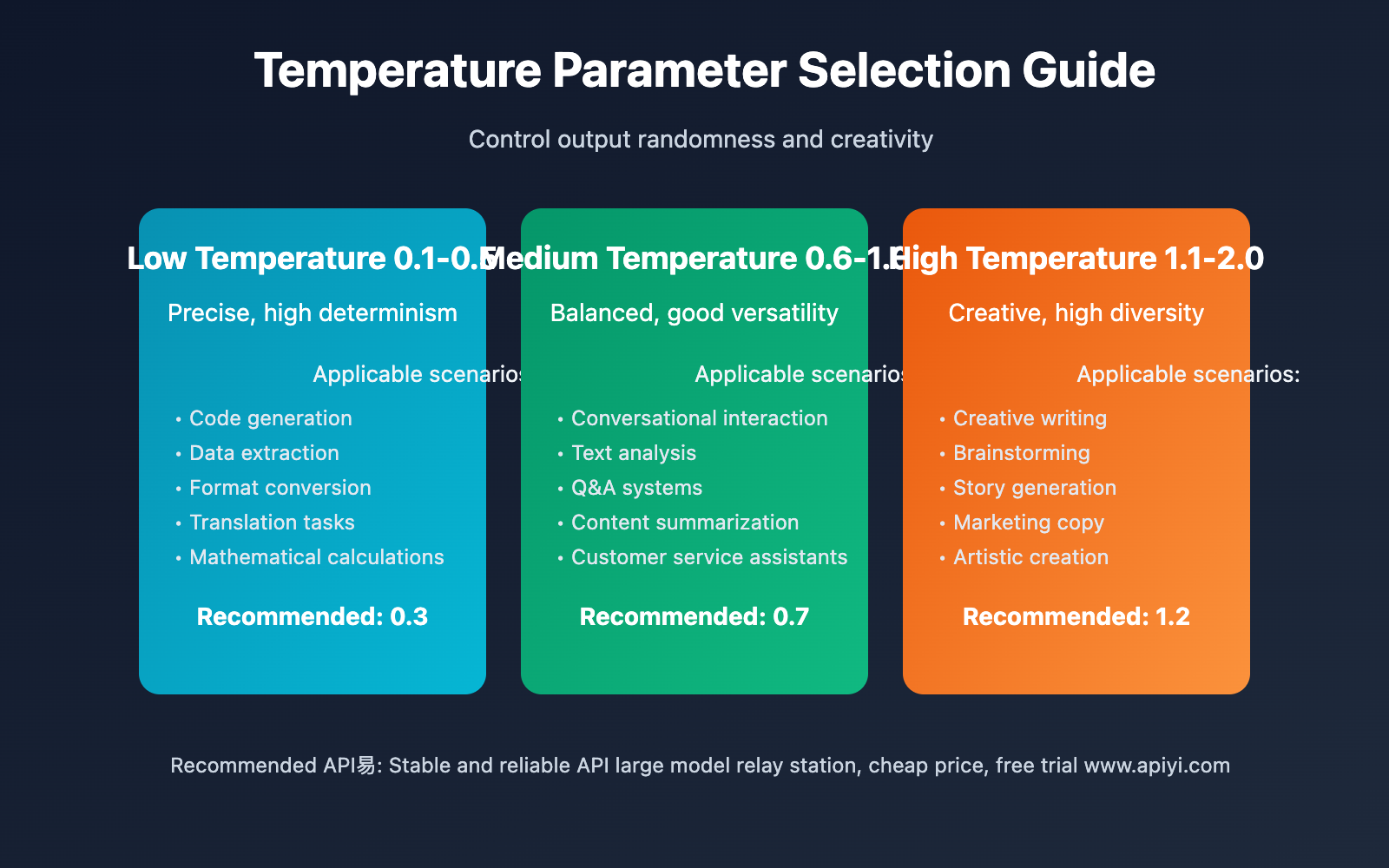
Claude Haiku 4.5 Beginner's Guide: Extended Thinking Usage Tutorial
Extended Thinking (Extended Reasoning) is Claude Haiku 4.5's most important new feature, allowing the model to perform deep reasoning.
What is Extended Thinking?
Extended Thinking allows the model to perform "internal thinking" before generating the final answer, similar to human problem-solving thinking processes:
- Thinking Phase: Model analyzes problems, plans steps, reasons logically
- Output Phase: Generates final answer based on thinking results
- Thinking Visibility: Can view the model's thinking process (optional)
Enable Extended Thinking
import anthropic
client = anthropic.Anthropic(api_key="your_api_key")
# Enable extended thinking
message = client.messages.create(
model="claude-haiku-4-5-20251001",
max_tokens=2048,
thinking={
"type": "enabled",
"budget_tokens": 10000 # Set thinking budget to 10K tokens
},
messages=[
{
"role": "user",
"content": "Design a high-concurrency message queue system, what key factors need to be considered?"
}
]
)
# View thinking process
for block in message.content:
if block.type == "thinking":
print("=== Thinking Process ===")
print(block.thinking)
elif block.type == "text":
print("=== Final Answer ===")
print(block.text)
thinking_budget Configuration Strategy
| Task Complexity | Recommended Budget | Applicable Scenarios |
|---|---|---|
| Simple Tasks | 1K-5K | Simple Q&A, basic code generation |
| Medium Tasks | 10K-30K | System design, algorithm analysis |
| Complex Tasks | 50K-128K | Architecture design, deep reasoning |
| Extremely Complex Tasks | 128K-256K | Research analysis, multi-step planning |
Practical Application Examples
Example 1: Code Debugging
message = client.messages.create(
model="claude-haiku-4-5-20251001",
max_tokens=2048,
thinking={
"type": "enabled",
"budget_tokens": 20000
},
messages=[
{
"role": "user",
"content": """
The following code has a bug, please find the problem and fix it:
def calculate_average(numbers):
total = 0
for num in numbers:
total += num
return total / len(numbers)
# Test
print(calculate_average([]))
"""
}
]
)
The model will first "think":
- Analyze code logic
- Identify boundary conditions
- Discover empty list causes division by zero error
- Design fix solution
Then output the fixed code.
Example 2: System Design
message = client.messages.create(
model="claude-haiku-4-5-20251001",
max_tokens=4096,
thinking={
"type": "enabled",
"budget_tokens": 50000 # Use more budget for complex tasks
},
messages=[
{
"role": "user",
"content": "Design a short video recommendation system supporting 10 million DAU"
}
]
)
The model will think about:
- System architecture selection
- Database design
- Caching strategy
- Recommendation algorithms
- Performance optimization solutions
Extended Thinking Best Practices
When to use Extended Thinking?
- ✅ Complex reasoning tasks
- ✅ Problems requiring multi-step analysis
- ✅ System design and architecture planning
- ✅ Code debugging and optimization
- ✅ Mathematical proofs and logical reasoning
When not needed?
- ❌ Simple Q&A
- ❌ Format conversion
- ❌ Direct data extraction
- ❌ Basic translation tasks
💰 Cost Optimization Recommendation: Extended Thinking consumes additional token costs. We recommend using API易 apiyi.com for cost monitoring and budget management. The platform provides real-time token usage statistics and cost estimation tools to help you better control costs when using Extended Thinking features.
Claude Haiku 4.5 Beginner's Guide: Frequently Asked Questions
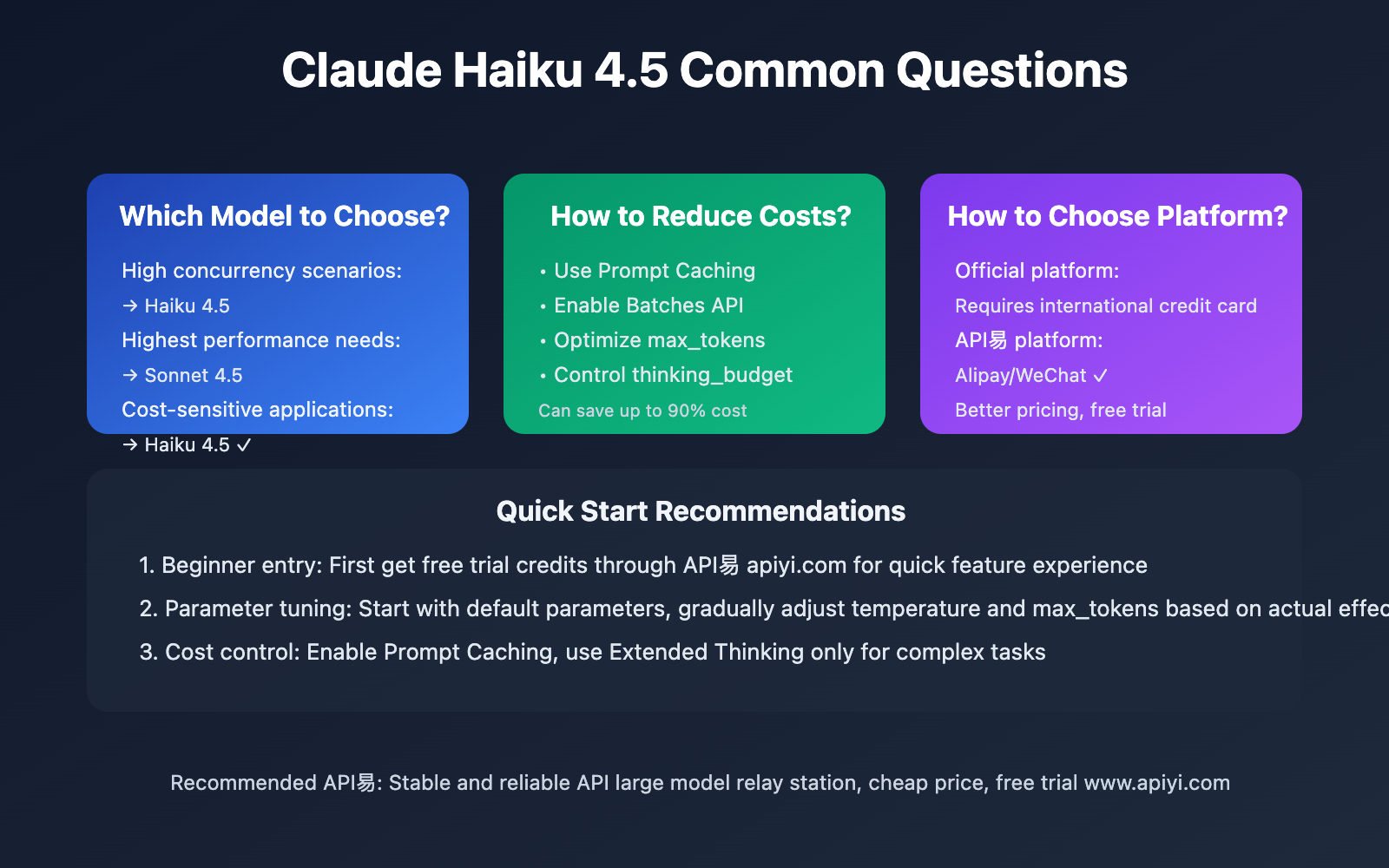
Q1: Should I choose Haiku 4.5 or Sonnet 4.5?
Selection Criteria:
Scenarios for choosing Haiku 4.5:
- ✅ High concurrency, real-time response needs (like chatbots)
- ✅ Cost-sensitive applications (like free user tiers)
- ✅ Coding assistance and automation tasks
- ✅ Sub-agents in multi-agent systems
- ✅ Need for rapid iteration testing
Scenarios for choosing Sonnet 4.5:
- ✅ Need for highest performance complex reasoning
- ✅ Scenarios with extremely high accuracy requirements
- ✅ Cost is not a primary consideration
- ✅ Research and advanced analysis tasks
Recommended Strategy: We suggest first testing both models simultaneously on API易 apiyi.com, comparing actual effects and costs. The platform supports seamless switching between models, facilitating A/B testing.
Q2: How to get free trial credits?
Multiple free trial methods:
- Anthropic Official: New users get small amount of free credits upon registration
- API易 Platform: Free trial tokens upon registration, can directly experience Claude Haiku 4.5
- Cloud Platforms: AWS Bedrock and GCP Vertex AI also provide free tiers
Recommended Solution: For domestic developers, the fastest way is to visit API易 apiyi.com, claim free credits after registration without needing international credit cards, supports Alipay and WeChat Pay for top-up.
Q3: How much cost does Extended Thinking add?
Cost Calculation:
Extended Thinking's thinking process consumes input tokens, billed at $1/MTok.
Example costs:
- 10K thinking budget = $0.01
- 50K thinking budget = $0.05
- 128K thinking budget = $0.128
Optimization suggestions:
- Set 1K-5K budget for simple tasks
- Use Extended Thinking only for complex tasks
- Monitor token usage in real-time through API易 apiyi.com's cost monitoring tools
Q4: How to handle API call errors?
Common errors and solutions:
Authentication Error (401):
- Check if API Key is correct
- Confirm API Key hasn't expired
- Verify request header format
Rate Limiting (429):
- Implement exponential backoff retry mechanism
- Use Batches API for batch processing
- Upgrade to higher rate limit tiers
Timeout Error:
- Increase request timeout time
- Choose stable API service providers
- Use API易 apiyi.com's load balancing features
Professional Recommendation: To ensure application stability, we recommend choosing service providers with multi-node deployment and intelligent routing capabilities. API易 apiyi.com provides global multi-node deployment, effectively reducing timeouts and failure rates.
📚 Claude Haiku 4.5 Beginner's Guide: Extended Learning Resources
🛠️ Official Documentation
| Resource Type | Content Description | Access Method |
|---|---|---|
| Model Overview | Claude full series model comparison | docs.anthropic.com/models |
| API Reference | Complete API call documentation | docs.anthropic.com/api |
| Extended Thinking | Detailed explanation of Extended Thinking features | Official tech blog |
| Best Practices | Anthropic recommended usage guidelines | Developer documentation |
🔗 Third-party Resources
API易 Platform Documentation:
- Quick start guide: help.apiyi.com
- Price comparison tool: apiyi.com/pricing
- Free trial: apiyi.com/free-trial
📖 Learning Recommendation: To better master Claude Haiku 4.5 usage techniques, we recommend learning through practical projects. You can visit API易 apiyi.com to get free developer accounts and deepen understanding through actual calls. The platform provides rich code examples and practical cases to help you get started quickly.
📊 Performance Benchmarking
To gain deeper understanding of Claude Haiku 4.5's performance, you can refer to:
- SWE-bench: Coding capability evaluation
- OSWorld: Computer usage capability evaluation
- Terminal-Bench: Terminal automation evaluation
Practical Recommendation: Regularly follow AI technology development trends. We recommend visiting API易 help.apiyi.com's tech blog and update logs to learn about the latest model releases and feature updates, maintaining technological leadership advantages.
🎯 Summary
This article detailed Claude Haiku 4.5's core features, acquisition methods, calling methods, and best practices, helping beginners quickly get started with this cost-effective AI model.
Key Review:
- Core Advantages: Close to Sonnet 4 performance, 4-5x faster speed, only 1/3 cost
- Acquisition Methods: Multiple choices including official platform/cloud platform/API易, domestic users recommended API易
- Basic Calls: Supports multiple languages including Python/JavaScript/cURL
- Parameter Configuration: temperature controls creativity, thinking_budget controls thinking depth
- Extended Thinking: Secret weapon for complex tasks, configure budget reasonably
- Cost Optimization: Prompt Caching + Batches API can save up to 90% cost
Practical Recommendations:
- Quick Start: First get free trial credits through API易 apiyi.com
- Parameter Tuning: Start with default configuration, optimize gradually based on effects
- Cost Control: Enable caching, use Extended Thinking reasonably
- Performance Monitoring: Use platform tools to track token usage and costs
Final Recommendation: For individual developers and small-medium enterprises, we strongly recommend using API易 apiyi.com as the access platform for Claude Haiku 4.5. It not only provides more convenient payment methods (supports Alipay/WeChat) and better pricing, but also has comprehensive monitoring, billing, and technical support systems that can significantly improve development efficiency and reduce operational costs. Visit apiyi.com now to claim free trial credits and start your AI development journey.
📝 Author Bio: Senior AI application developer, focused on large model API integration and architecture design. Regularly shares AI development practical experience. More technical materials and best practice cases available at API易 apiyi.com technical community.
🔔 Technical Exchange: Welcome to discuss Claude Haiku 4.5 usage techniques and experience in the comments section. For in-depth technical support, contact our technical team through API易 apiyi.com.

